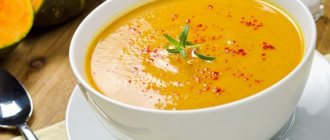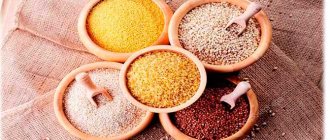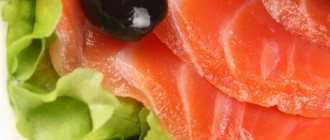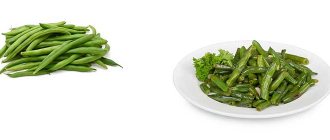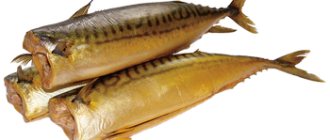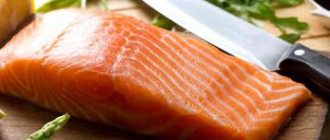Composition and calorie content of salmon
Salmon fillet has a rich composition of nutrients. With minimal heat treatment, the meat fully retains its nutritional value.
100 g of fish contains the following elements:
| Substances that make up fish | Quantitative indicator | Brief description of them |
| Squirrels | 23.21 g | Normalize the activity of all organs and systems. |
| Fats | 14.83 g | They replenish energy reserves and normalize metabolic processes in the body. |
| Cholesterol | 1.13 g | Normalizes hormonal balance and participates in metabolic processes. |
| Iron | 0.82 mg | Participates in the formation of hemoglobin in the blood. |
| Zinc | 0.68 mg | Helps strengthen the immune system. |
| Chromium | 0.56 mg | Normalizes glucose concentration. |
| Molybdenum | 0.35 mg | Takes part in metabolic processes in the body. |
| Potassium | 363.22 mg | Ensures normal functioning of the nervous system. |
| Sulfur | 198.91 mg | Normalizes the activity of nerve cells and the concentration of glucose in the blood. |
| Sodium | 58.98 mg | Regulates the production of enzymes in the digestive tract and water-salt balance. |
| Calcium | 9.53 mg | Normalizes blood composition and nervous system activity. |
| Phosphorus | 209.11 mg | Participates in energy metabolism and ensures the strength of teeth and bones. |
| Magnesium | 29.99 mg | Normalizes the activity of the nervous system. |
| Chlorine | 164.13 mg | Regulates the concentration of glucose in the blood. |
| Iodine | 223.14 mg | Normalizes the activity of the thyroid gland. |
| Cobalt | 1.28 mg | Participates in metabolic processes. |
| Copper | 0.58 mg | Normalizes the activity of the cardiovascular system, participates in metabolic processes. |
| Vitamins | A 0.32 mg | Helps strengthen immunity and vision. |
| RR 9.92 mg | Normalizes metabolic processes in the body. | |
| E 2.53 mg | Regulates blood composition and nervous system activity. | |
| B1 0.16 mg | Participates in metabolic processes and supports the functioning of the nervous system. | |
| B2 0.19 mg | Normalizes light perception. | |
| B5 5.63 mg | Participates in metabolic processes and hormone production. | |
| B 6 5.92 mg | Helps strengthen the immune system and ensure normal blood composition. | |
| B12 22.11 mg | Normalizes metabolism and blood composition. | |
| D 6.02 mg | Ensures the formation and strength of bone tissue. |
There are no carbohydrates in salmon meat, which makes it possible to include fish dishes in the menu for people on a diet and with diabetes.
Composition and calorie content of salmon
The energy value of salmon (in kcal) per 100 g depends on the processing method:
- fresh – 154;
- boiled – 151;
- steamed - 134;
- baked – 187;
- grilled – 198;
- fried – 239;
- smoked – 198;
- lightly salted – 201.
The most healthy and nutritious salmon is steamed, boiled and lightly salted.
What's the benefit?
Salmon contains a lot of useful substances. These are vitamins of group B, as well as A, C, D, E and PP. It also contains many trace elements such as sodium, phosphorus, potassium, fluorine, iodine, sulfur, chlorine and others.
Yes, this marine inhabitant is not low-calorie. However, due to the fact that it contains fats and proteins, but absolutely no carbohydrates, the dish you eat will not put extra centimeters on your waist.
Moreover, this product contains the Omega-3 amino acid and several other fatty acids, which promote the breakdown of fat and have an extremely beneficial effect on metabolism. The calorie content of salmon is quite high and yet it is perfect for people who want to lose weight.
In terms of its properties, this sea creature is simply a Goldfish. It is recommended for use by both children and adults. It will be useful for men and women, people engaged in mental work and workers with heavy physical activity.
The benefits and harms of lightly salted salmon
Lightly salted salmon, the recipes for which are described later in the article, can have both positive and negative effects on the body when consumed.
| Benefit | Harm |
| Helps eliminate depression and nervous tension by normalizing the activity of the nervous system. | May cause an allergic reaction. |
| Increases the body's resistance to various pathogens. | If you buy expired fish or that have been stored improperly, your body may be poisoned. |
| Strengthens and promotes the development of bone and muscle tissue. | May cause increased blood pressure |
| Normalizes the condition of blood vessels and blood composition. | Deterioration of kidney function due to the presence of salt in the finished product. |
| Improves the activity of the cardiovascular system. | Deterioration of the condition in case of gallstones and urolithiasis (due to salt content). |
| During pregnancy, it promotes the normal formation and development of the fetus. | |
| Normalizes the concentration of sugar, cholesterol and promotes weight loss. | |
| Improves the activity of brain cells, increasing memory and alertness. |
Harm from lightly salted salmon occurs when it is consumed excessively, as heavy metals accumulate in fish fillets.
Salmon danger
Of course, like any product, this fish has its contraindications. Not all people are recommended to eat it.
You should beware of red fish if:
- You have allergic reactions to salmon or seafood in general;
- You suffer from urolithiasis and kidney disease;
- you have liver problems;
- Have stones in the kidneys or gall bladder;
- You have inflammation in the gastrointestinal tract;
- You suffer from high blood pressure;
Also, beware of eating raw sea creatures, as they may contain various parasites. A raw product can only be eaten if it has quality certificates and veterinary permits. A fish that is too brightly colored will not do you any good, as it is most likely tinted with dyes. Salmon has a high calorie content and is therefore not recommended for obese people.
How to choose salmon for salting
Salmon for sale can come either from the sea or artificially grown. Fish caught in the sea has the greatest beneficial qualities. It does not contain chemical additives that were used to accelerate growth and increase weight.
How to choose salmon for salting
When choosing fresh frozen salmon, you should pay attention to the following qualities:
- The fish fillet should only be soft pink in color and elastic (when pressed, the fibers quickly straighten). Darker color is characteristic of “old” fish. And the bright pink tone means the use of dyes to give the meat a more attractive appearance;
- the fillet is loose and pale pink in color, which means the carcass has been defrosted multiple times;
- the scales are slightly damp, but without excess shine, without mucus and stains;
- eyes should be transparent and not sunken;
- gills are pink, the presence of a brown tint is characteristic of stale fish;
- When buying fish without a head or fillet, the edges of the cut should be smooth. The blurriness characterizes the soaking of the fish;
- there should be white streaks in the meat;
- The fish has a characteristic marine smell. A fishy aroma develops during long-term storage.
The shelf life of fresh frozen fish is no more than 14 days. When choosing frozen fish, there should be no ice or snow in the packaging. Their presence means repeated defrosting or improper storage.
How many calories are in salmon?
The calorie content of salmon varies from 140 to 230 kcal per 100 g of product. What does this really mean?
As mentioned above, the number of red fish decreased sharply in the middle of the twentieth century, when industrial technologies increased the catch tens and hundreds of times. Instead of frail fishing schooners, huge tankers began to go out to sea, casting nets for many miles around and catching whole schools of fish. Over the decade of such a barbaric attitude towards the gifts of nature, red fish grown in natural conditions has become a real rarity.
For more than 20 years in the world there has been a practice of growing valuable fish species on special farms. Reservoirs limited in area contain such a quantity of fish that not a single individual is able to swim or move fully - there is too little space. But there is a lot of feed, which contributes to rapid weight gain (mainly due to fat) and, as a result, an increase in calorie content.
Artificially grown salmon will always have more calories than salmon grown in natural conditions. While in the sea or lake (lacustrine species), the fish moves a lot in freedom - it needs to get food for itself and ensure its livelihoods, so the calorie content of salmon caught in the sea will be no more than 160-180 kcal/100 g.
At the same time, the calorie content of farmed salmon is also influenced by the quality of feed. They often contain antibiotics and pigments, as well as modified additives. The quality indicator decreases significantly, but the number of calories increases and sometimes reaches 228-230 kcal/100g.
It goes without saying that the nutritional value of such fish is much lower than that grown in its natural habitat. Too high calorie content of salmon only indicates that the fish was overfed with artificial feed, and not about its biological value.
How to cut fish for salting. Methods, pros and cons
Lightly salted salmon (recipes often call for already prepared fillets) can be prepared in a variety of ways. Cooking may require only the fillet, or the whole fish. It is important to be able to properly cut fish for the chosen salting.
How to cut fish for salting. Methods, pros and cons
Nuances of preparing salmon for salting:
- Rinse the carcass, remove scales, fins and head.
- Remove the insides, rinse the fish with water and dry.
- Next, the fish is cut according to the requirements in the recipe.
Salmon cutting methods:
| Type of salmon cutting | Description of cutting | pros | Minuses |
| Entirely | Salmon can be salted whole, after removing the head, fins and scales. |
|
|
| Pieces | The prepared fish is cut into portions of 3-4 cm, without removing the bones. |
|
|
| Fillet | It is necessary to remove the skin from the cleaned fish in the direction from the head to the tail. It is easily removed due to the layer of fat. The skin must be cut off from the caudal fin. Next, you need to carefully separate the ridge from the fillet, without using a knife. The main bones will remain on the skeleton. If there are small bones in the meat, they can be removed using tweezers. The fillet is ready for salting. |
|
|
| Portioned fillet | Cut the finished fillet into portions |
|
|
Additionally, for salting salmon it is recommended:
- buy fresh or frozen fish;
- use only coarse salt;
- salt only in enamel or glass containers.
The choice of cutting the carcass can be done independently, depending on the further use of the finished meat.
Salmon in the diet of those who watch their figure
Regarding the form in which this fish is best eaten, there are no changes compared to other meat and seafood products. The most ideal thing is steaming. The calorie content of salmon cooked using a double boiler will reach 178 kcal, but due to the high protein content, even a hundred-gram piece will give you a feeling of fullness for a long time. You can supplement this lunch or dinner - the calorie content of steamed salmon and its overall lightness allow you to consume this dish at any time of the day - with vegetables or rice. Approximately the same picture will be for oven-baked fish, provided there is no fat in the form of butter or mayonnaise. The seafood itself can do without such additives: the meat will not become tough by the time it is ready. But if you wish, you can sprinkle it with lemon juice, which will benefit your slimness. As for how many calories are in salmon cooked in foil, this figure will stop at 102 kcal per hundred grams.
Among those products with which this fish works well in tandem, allowing you not only to avoid gaining excess weight, but also to burn hated fats, there are definitely cucumbers. Considering their satiety characteristics, we can say with confidence that the calorie content of steamed salmon with the addition of fresh finely chopped cucumber will seem ridiculous in comparison with how strongly such a combination repels the feeling of hunger. To enhance the effect, it is recommended to decorate the dish with herbs: parsley, dill or onion.
Salmon is a favorite delicacy of many people. Its delicate, pleasant taste makes it an almost obligatory guest on a rich table, and its composition makes it an excellent dietary product that is incredibly beneficial for the body. You will learn how many calories are in salmon, and whether it can be included in the menu when losing weight, from this article.
Calorie content of fresh salmon
Fresh and lightly salted salmon, which is sold in vacuum packaging, has the same calorie content - 219 units for every 100 g. Most of the product is represented by proteins - there are 20.8 g of them, and a smaller part is fats: 15.1 g. There are no carbohydrates in salmon at all , and it is equal to zero (this information is relevant for those who suffer from diabetes).
The calorie content of salmon fillet, which can be purchased in stores, is usually 202 kcal. This product is often separated from the fattest parts, resulting in a lower energy value.
Calorie content of fried salmon
As a rule, after frying, foods become more nutritious, but in the case of salmon this does not work. During any heat treatment, fats are melted out of it, and its calorie content is reduced - from 219 kcal to 197 kcal.
If you bake salmon in foil, its calorie content will also be 197 kcal. Based on this, you can diversify your menu by eating this delicious fish in a variety of forms.
There will be even fewer calories in salmon if it is boiled - only 167 units. Therefore, salmon soup turns this fish into an excellent dietary product, incredibly healthy and tasty.
Is it possible to include salmon in a diet for weight loss?
Salmon is not only tasty, but also healthy. Its composition includes B, C, H, PP and D, micro- and macroelements - iodine, potassium, calcium, sodium, magnesium and many others. Added to this rich composition is the essential amino acid omega-3, which is not produced by the human body, which means it is important to obtain it from food.
Regular consumption of salmon can easily be included in a healthy nutrition system:
- Breakfast – oatmeal with apple, tea.
- Lunch – salmon fish soup, or salmon with vegetables and rice.
- Afternoon snack – a glass of kefir.
- Dinner – meat/poultry/fish with a side dish of vegetables.
Eating salmon during a diet allows you, even with a greatly reduced diet, to give the body everything it needs, so you will not experience such side effects of an incorrect diet as brittle nails, dull hair, problematic skin and pain of various origins.
Posting ads is free and no registration is required. But there is pre-moderation of ads.
Salmon belongs to the salmon family; it is considered an anadromous fish and is a valuable commercial object. The maximum weight of one individual can reach 40 kg, and the length can be more than 1 meter. The fish has small scales and does not have any spots below the lateral line. Habitat: the Atlantic and Arctic Oceans, the Baltic Sea.
In the autumn-summer period, Salmon is able to move to freshwater bodies with the current. Spawning occurs in the autumn, when the fish becomes covered with characteristic red spots on the head and sides. Freshwater Salmon feeds on invertebrates and small fish; marine species prefer to feast on crustaceans.
Salmon meat includes a wide range of valuable components. Vitamins: PP, , H, vitamin C, B, vitamin D. Microelements: fluorine, zinc, magnesium, calcium, sodium, potassium, iodine, phosphorus. It is also worth noting the high content of proteins and Omega-3 fatty acids.
Classic recipe for lightly salted salmon using the dry method
To salt salmon you will need:
| Main Ingredients | Quantitative indicator in pcs. | Weight in g and ml |
| Salmon carcass | — | 1000 |
| Granulated sugar | — | 20 |
| Sea salt | — | 40 |
| Ground white pepper | — | 5 |
| Fresh sprigs of dill | — | 5 |
Classic recipe for lightly salted salmon using the dry method
Salting sequence:
- Cut the carcass into pieces. Rinse with water and dry.
- Mix salt with granulated sugar and pepper.
- Chop the dill and add to the salt mixture. To stir thoroughly.
- Place the salmon pieces in a suitable size container. Sprinkle each layer of fish with the salt mixture.
- Cover the contents of the pan with a plate of suitable diameter and press down with pressure. Place in the refrigerator.
The fish is ready to eat in 10-14 hours (depending on the size of the pieces).
Calorie content of lightly salted salmon
Lightly salted salmon is a favorite delicacy in Russian cuisine. Who will remain indifferent to a piece of tender pulp on a fragrant slice of bread with butter? And small canapés with an openwork salmon rose and an olive - they seem to just melt in your mouth. Yes, the temptation is really great, but those who watch their figure will be pleased to know that the calorie content of lightly salted salmon is not so high. In fact, it is almost no different from the caloric content of fresh fish and is 165-180 kcal/100 g of product, sometimes reaching 216-228 kcal/100 g, which is explained by the high initial caloric content of fresh fish.
The recipe also plays a role: in some regions, it is customary to add sugar and various spices along with salt, in others - lemon and fragrant herb roots cut into slices. In the classic recipe, salmon is rubbed with coarse salt and left to salt for several days. In the latter case, the calorie content of lightly salted fish will not differ significantly from raw fish.
Vegetable oils, which are often present in vacuum-packed products, significantly increase the calorie content (by almost a third). Vegetable oil is almost one hundred percent fat, so the calories in such fish can reach 240 kcal/100 g.
Recipe for lightly salted salmon pieces in orange juice
To salt salmon you will need:
| Main Ingredients | Quantitative indicator in pcs. | Weight in g and ml |
| Fresh frozen salmon carcass | — | 1000 |
| Cumin seeds | — | 10 |
| Fresh orange | 3 | — |
| Ground coriander | — | 3 |
| Pickling salt, coarse | — | 100 |
| Dill sprigs | — | 5 |
Recipe for lightly salted salmon pieces in orange juice
Salting sequence:
- Cut the carcass into pieces. Bones can be removed if desired.
- Mix cumin, ground coriander and chopped dill. Mash the contents with a masher.
- Squeeze juice from oranges. Boil until ½ of the juice evaporates.
- Lay out the salmon in layers. Sprinkle each layer with the prepared spice mixture.
- Sprinkle the last fish layer with salt and pour cold orange juice.
Keep the pan with fish warm for 1 hour and cold for 8 hours. Cover the container with a paper or cloth towel.
Lightly salted salmon according to a quick recipe with vodka
Lightly salted salmon with the addition of vodka retains its juice and elastic consistency. Instead of vodka in the recipe, you can use cognac, depending on your taste preferences.
To salt salmon you will need:
| Main Ingredients | Quantitative indicator in pcs. | Weight in g and ml |
| Prepared fillet | — | 1000 |
| Vodka | 50 | |
| Pickling salt | 50 | |
| Granulated sugar | 20 | |
| Dill sprigs | 5 |
Lightly salted salmon according to a quick recipe with vodka
Salting sequence:
- The fillet can be used whole or divided into portions.
- Mix chopped dill, granulated sugar and salt.
- Coat the fillet thoroughly with the salt mixture. Place in a container.
- Sprinkle the fillets with vodka and cover the pan with cling film.
- Let the salmon soak in the mixture in a warm place for 2-3 hours.
The fish can be consumed immediately. But it’s better to let it sit overnight in the refrigerator.
Recommendations for use
Fresh fish is available to residents of the fishing grounds. More often it goes on sale frozen.
After purchasing frozen fish, the carcass or steaks are left in the refrigerator until completely thawed. This way, beneficial cellular juices will remain in the meat.
Whole fish are thoroughly washed, scaled, the head is cut off, gutted, cut into portions or salted whole or subjected to further culinary processing.
Boiling, steaming, grilling, and baking allow you to quickly cook tender meat , preserving all the benefits without increasing the calorie content of the dish. It is recommended to eat salmon with vegetables for lunch or dinner, no later than 3-4 hours before bedtime.
It is advisable for a healthy person to include fish products in their diet 2 times a week, one of which is a fatty variety. The recommended 70-100 grams of salmon will cover half of the body’s daily requirement in proteins.
It is forbidden to consume more than 250 g per day due to the large amount of protein.
How else to cook salmon tasty and healthy, watch in this video:
Salting fish with lemon
To salt salmon you will need:
| Main Ingredients | Quantitative indicator in pcs. | Weight in g and ml |
| Fresh salmon fillet | — | 1000 |
| Fresh lemon juice | — | 100 |
| Powdered sugar | — | 30 |
| Canning salt | — | 100 |
Salting fish with lemon
Salting sequence:
- Rinse and dry the fillet
- Mix salt and sugar. Add lemon juice (20 ml) to the mixture.
- Brush the fillet on all sides with the salt mixture and place in the pan.
- Pour the remaining lemon juice over the fish fillets.
- Cover the pan with film and place in the refrigerator for 10-12 hours.
Turn the fillet over and leave to salt for another 12 hours.
Lightly salted salmon in brine
To salt salmon you will need:
| Main Ingredients | Quantitative indicator in pcs. | Weight in g and ml |
| Fresh salmon carcass | — | 1000 |
| Drinking water | — | 1000 |
| Coarse salt | — | 100 |
| Lemon juice | — | 30 |
| Dried cloves | 2 | — |
| Black pepper in the form of peas | 2 | — |
| Laurel leaves | 2 | — |
| Allspice in the form of peas | 2 | — |
Lightly salted salmon in brine
Salting sequence:
- Prepare the brine using all the ingredients except the fish itself.
- Cool the brine and strain.
- The fish can be cut into fillets or pieces, as desired. Pour in the prepared brine. The salmon should be completely covered with it. Cover with a lid.
The fish should sit in the refrigerator for a day.
Salting salmon in beets
To salt salmon you will need:
| Main Ingredients | Quantitative indicator in pcs. | Weight in g and ml |
| Fresh salmon fillet | — | 500 |
| Fresh beets, grated | — | 200 |
| Horseradish root, grated | — | 20 |
| Vodka | — | 30 |
| Lemon zest | — | 15 |
| Dill sprigs | — | 5 |
| Granulated sugar | — | 30 |
| Pickling salt | — | 130 |
Salting salmon in beets
Salting sequence:
- Rub the fillet with salt and sprinkle with sugar.
- Mix the horseradish and beets and place the mixture on top of the fillet.
- Sprinkle with chopped dill, lemon zest and vodka on top.
- The fish is wrapped in cling film. And put it in the refrigerator.
The salmon will be ready in 48 hours.
Salting the backbone and belly of salmon for beer at home
Lightly salted salmon (this recipe is the most economical) for beer is popular among men.
To salt salmon you will need:
| Main Ingredients | Quantitative indicator in pcs. | Weight in g and ml |
| Belly or spine of salmon | — | 500 |
| Pickling salt | — | 30 |
| Granulated sugar | — | 15 |
Salting sequence:
- Rinse the abdomen/ridge and dry.
- Mix salt and sugar and sprinkle the mixture over the belly/backbone.
- Place everything in a jar with a lid for the pickling period. And place it in the refrigerator.
Serve after 8 hours.
How to salt whole salmon deliciously?
To salt salmon you will need:
| Main Ingredients | Weight (g or ml) |
| Prepared salmon carcass, fresh | 2000 |
| Coarse salt | 200 |
| Granulated sugar | 100 |
How to salt whole salmon deliciously?
Salting sequence:
- Mix sugar and salt and rub the salmon carcass with this mixture.
- Place the carcass in a bag and put it in the refrigerator.
The salmon will be salted in 12 hours.
Salting salmon fillet
To salt salmon you will need:
| Main Ingredients | Quantitative indicator in pcs. | Weight in g and ml |
| Fresh salmon fillet | — | 1000 |
| Pickling salt | — | 120 |
| Granulated sugar | — | 60 |
| Vegetable oil | — | 50 |
| Dill sprigs | — | 10 |
Salting salmon fillet
Salting sequence:
- Mix salt with chopped dill and sugar.
- Rub the fillet with the mixture.
- Place the fish in a tight container or bag. Place in the refrigerator.
- In 24 hours, lightly salted salmon will be ready, after 2 days, lightly salted fillet, and after 72 hours, salted salmon.
- Remove the fillet depending on the desired result. Drain the liquid and brush the salmon with oil. Place in a clean container.
Consume fish within 7 days.
Calorie content of salmon for various cooking methods
There are many delicious salmon dishes. Their preparation may take very little time, but the end result will be magnificent - red fish has a delicate, unique taste. Depending on the components included in the recipe, as well as on the type of heat treatment, the calorie content of salmon may vary.
We offer you a list of the most popular salmon dishes, taking into account calorie content (per 100 g of finished product):
- boiled - 170-189 kcal;
- fried in portions – 191-197 kcal;
- fried in batter – 265.9 kcal;
- baked whole carcass in foil – 156-180 kcal;
- grilled – 190-210 kcal;
- with cheese sauce – 230 kcal;
- baked on coals – 187 kcal;
- fried on the grill – 140-160 kcal;
- ear – 66-77 kcal.
As you can see, the lowest calorie dishes are fish soup and fish fried on the grill. The calorie content of the salmon in the first course was reduced due to the liquid and a small amount of the fish itself (approximately 50-60 g per serving), but in the second course - due to the absence of additional fats and sauces.
Popular articles Read more articles
02.12.2013
We all walk a lot during the day. Even if we have a sedentary lifestyle, we still walk - after all, we...
604760 65 More details
10.10.2013
Fifty years for the fair sex is a kind of milestone, crossing which every second...
444184 117 More details
This fish is just a treat! A delight for the eyes, taste buds and the whole body! No one should be afraid of her, neither big nor small, nor thin, nor chubby. Salmon is good for everyone, you just need to know how to cook it correctly.
In this article we will take a closer look at this representative of salmon and learn several recipes for a snack...
How to salt salmon caviar?
To salt salmon caviar you will need:
| Main Ingredients | Quantitative indicator in pcs. | Weight in g and ml |
| Salmon caviar without film | — | 300 |
| Drinking water | — | 200 |
| Coarse salt | — | 50 |
| Granulated sugar | — | 50 |
How to salt salmon caviar?
Salting sequence:
- Prepare a brine from salt and sugar. Cool to 70 degrees.
- Place caviar in brine for 15 minutes.
- The brine is drained and the caviar is dried for 2 hours.
Place the caviar in a jar greased with vegetable oil. Keep refrigerated.
Salted salmon in oil
Lightly salted salmon (the recipe with the addition of oil allows you to prepare juicy even frozen fish), prepared in this way, can be stored for a long time.
To salt salmon you will need:
| Main Ingredients | Quantitative indicator in pcs. | Weight in g and ml |
| Portioned salmon fillet | — | 500 |
| Vegetable oil | — | 100 |
| Granulated sugar | — | 15 |
| Coarse salt | — | 50 |
Salted salmon in oil
Salting sequence:
- Dissolve sugar and salt in butter.
- Place the fillet in a jar and fill with the prepared oil mixture. Stir and cover with a lid.
After 18 hours, the fillet is ready.
What can you cook from lightly salted salmon?
Lightly salted salmon is both an independent dish and an ingredient in salads and appetizers.
Recommended recipes with lightly salted salmon:
| Name of the dish | Ingredients | Cooking rules |
| Canapes |
|
|
| Fish roll |
|
|
| Stuffed eggs |
|
|
| Lavash with salmon and ham |
|
|
Lightly salted salmon fillets can be used to prepare a variety of baguette-based sandwiches. The type and quantity of ingredients is determined as desired.
Application
Salmon is best known to a wide range of consumers in its smoked and lightly salted form. This is usually presented as a cold appetizer or delicacy. This fish is often present in salads and light snacks, and is used as a filling for rolls. Moreover, it can be purchased in ready-salted form or marinated at home with the addition of your favorite spices and seasonings.
But fresh Salmon has a distinct taste, from which it is customary to prepare delicate and appetizing creamy soups. This fish is also suitable for frying, and it can be combined with the most common and affordable products - side dishes, marinades, sauces. To preserve all the nutrients included in the product described, it is recommended to bake it on the grill or in foil in the oven.
Market Analytics
- Global cosmetics market 2021: an unprecedented test for the global cosmetics industry
- Top 10 Cosmetic Research and Development of 2021
- 2020 in the beauty industry – innovation without borders
Convenient search for beauty salons on our website
Beauty salons in Moscow Beauty salons in St. Petersburg Beauty salons in Ekaterinburg Beauty salons in Novosibirsk
Latest blog posts on our website
- Naturecream / Properties of the “Sunny” oil itself
- Naturecream / “Sugar” wrinkles - or what glycation can do
- Naturecream / Esterified oils
- Naturecream / Arnica - the magical plant of alchemists
- Naturecream / Tremella Extract - Snow Mushroom Detox for Skin
- Prostye-sovety / How to visually enlarge your lips with makeup
- Naturecream / Apricot kernel oil for face
- Naturecream / MATRIXYL3000 - the best skin elasticity stimulator
- Naturecream / SPF in Natural Oils
- Naturecream / Geranium (Pelargonium) oil for skin health and beauty
Latest forum topics on our website
- Natalya / How to properly make a gelatin mask?
- Mrs._Smith / Badly sunburned! What to do?((
- Ice / Is it necessary to combine fitness classes with a diet?
- Antonova / What can be used for hair loss?
- Radio operatorKat / Who was on a protein diet?
Other articles in this section
| Shrimp Shrimp are small species of crustaceans from the order Decapods, which are common in marine and fresh waters around the world. Currently, there are more than 2,000 species of shrimp, most of which are objects of industrial fishing. Depending on the species, the body length of adults can be from 3 to 35 cm, while shrimp that live in the southern regions are larger compared to deep-sea shrimp or arthropods that live in northern waters. |
| Boiled cod In the cod fish family, cod occupies a dominant place. It lives in most of the Atlantic Ocean and is divided according to geographical origin into: Baltic, Pacific, White Sea, Arctic, Greenland. Caught mainly in Norway, Russia, Denmark, Canada, etc. |
| Salted sturgeon Sturgeon belongs to the sturgeon family. According to experts, sturgeons are the most ancient freshwater fish on earth. This is confirmed by the fossilized remains of sturgeons found during archaeological excavations. Perhaps sturgeons lived during the time of dinosaurs. |
| Sprats Sprats have been a very popular product since the times of the Soviet Union. This unique taste is impossible to confuse. Sprat is a fish whose special taste qualities are emphasized in a special preservation recipe. |
| Smelt Smelt is known to everyone as a distant relative of the salmon family. This little fish is quite beautiful, it has a slightly translucent brown-green back and silvery sides with a blue tint. |
| Vendace Vendace is a freshwater fish of the salmon family. Outwardly it has similar features to herring, but is not related to this species. Its habitat is a fresh body of water, which is usually cold. Therefore, in Russia it occurs in Lakes Onega, Lake Peipsi and Lake Ladoga, and is sometimes found in the Gulf of Finland. She avoids shallow and warm waters. Denmark, Scotland, Finland are comfortable countries for her. |
| Steamed salmon Steaming food in modern Russia has gained popularity relatively recently. But, despite its youth, many housewives fell in love with this method of cooking. Many people especially like steamed salmon. After all, this is quite a satisfying and nutritious food, because this fish is quite fatty. And if the first two of its properties are often welcomed, then, you must admit, not everyone is ready to eat fatty fish. And the best way to get rid of this fat is to steam it. |
| Hot smoked cod Cod belongs to the cod family and is usually found in the Atlantic Ocean. Moreover, there are several subspecies of this fish, determined by geographical location: Baltic, White Sea, Arctic Cod. The maximum length is 1.8 m, but smaller individuals are caught on an industrial scale. This fish is distinguished by its bright and attractive color with specks, its belly is white, and there is a small antennae on the chin. |
| Fresh squid Squid is a very popular type of sea mollusk. Most often, squid individuals are found in small sizes. As a rule, they do not reach a length of 30 cm. But there are also known individuals that grow to gigantic parameters, for example, up to 20 meters long and weighing 300 kilograms. |
| Pangasius Pangasius belongs to marine fish from the Catfish family. For some reason, it is common to mistakenly call it the tongue of the sea. It is not right. Solefish belongs to a completely different family of fish. |
How to store salted salmon?
Recommendations for storing lightly salted salmon (in the refrigerator):
- When purchasing a finished product, salmon should be stored in the refrigerator for the period indicated on the package, while maintaining the integrity of the package. Once opened, it is recommended to consume the fish within 3 days;
- When prepared at home, fish can be stored for no more than 4 days;
- if the salmon is greased with oil and placed in a sealed package, its shelf life will increase to 7 days;
- If portioned salmon fillets are placed in a jar with vegetable oil and hermetically sealed, the shelf life increases to 3 months. But fish can change the taste;
- You can increase the shelf life, up to 15 days, by adding salt, but then the salmon will become salted rather than lightly salted.
Storage in the freezer is not recommended, as the fish becomes soft after defrosting, and the taste and healthiness change. But the shelf life increases to 6 months.
You can cook lightly salted salmon yourself. The advantage of cooking fish at home is adding salt and spices according to your own taste preferences. It is not recommended to salt a large amount of fillet, since in its finished form it can be stored for no more than 7 days. The fish retains all its nutritional properties if the cooking recipe is followed.
Fatty acid
The set of fatty acids in salmon allows you to get not only a delicious taste sensation, but also cosmetic benefits. After all, people who eat Atlantic salmon protect their skin from sunburn, as well as from negative sun rays in general. Moreover, the skin of salmon lovers becomes smoother, softer and healthier with each serving.
As you know, scientists never tire of repeating that the human body necessarily requires Omega-3 fatty acid, which, together with other acids, regulates metabolism and reduces the amount of bad cholesterol in the human body. So, salmon also contains a lot of Omega-3. So lean in...



